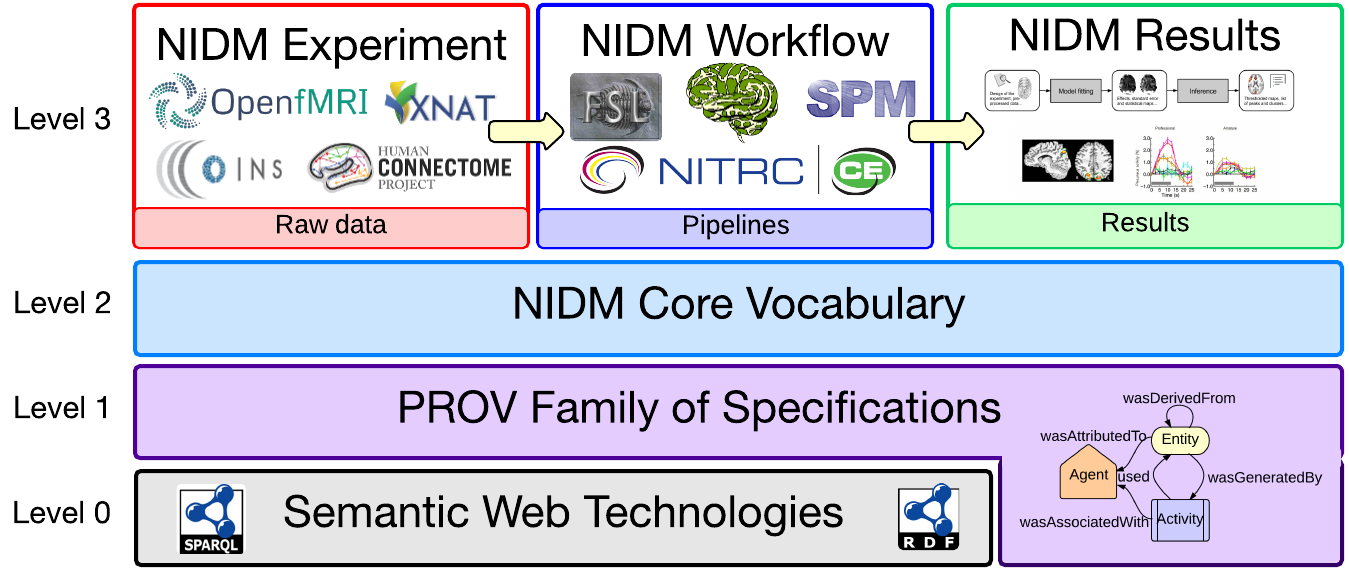Introduction
This document provides a non-normative overview of the Neuroimaging Data Model (NIDM) Family of Documents and a roadmap to using them. Neuroimaging is a research discipline that uses imaging technologies to observe neurobiology at all levels of analysis, from molecules to organ systems (i.e., the brain). The focus of these documents is currently on human neuroimaging using Magnetic Resonance Imaging (MRI); however, the concepts described herein are intended to generalize to other modalities (e.g., PET, EEG). The goal of NIDM is to enable the wide publication and interchange of provenance information related to neuroimaging research to enable reproducible findings, which ranges from the experimental design and data acquisition of individual participant data to the analysis and results that produce scientific findings.
The design of NIDM stems from the need to address metadata-related barriers to data sharing [[!KEATORNI13]] that impact the reproducibility of scientific discoveries in neuroimaging, which is a focus of the NIDM Working Group. Provenance information is a key aspect of reproducibility, and the NIDM Family of Documents adopted the W3C PROV Working Group's approach to developing data sharing standards by extending the W3C PROV Recommendations. This approach embeds provenance as a fundamental data sharing primitive that captures the details of how a given dataset or analysis was produced. Summarizing, NIDM Working Group recommends that the metadata for a data sharing framework should support:
- a core vocabulary of neuroimaging terms with definitions that extend PROV;
- a dataset descriptor that provides metadata about documents being shared;
- data structures to organize experiment data acquired in a neuroimaging project;
- data structures to model the provenance of computational neuroimaging workflow;
- data structures to model neuroimaging results across analysis software;
- an api to access and query provenance information and metadata from a neuroimaging project.
Figure 1 shows the organization of NIDM and how the specification documents relate to each other.
Underlying the NIDM Core is a conceptual data model called PROV ([[!prov-primer]], which defines a common vocabulary used to describe provenance. The PROV model is extended by the NIDM Core Vocabulary with terms that are used to describe neuroimaging research, and each term is designated as a PROV Entity, Activity, Agent, or Attribute. In the next layer, NIDM defines the Experiment ([[!nidm-experiment]]), Workflow ([[!nidm-workflow]]), and Results ([[!nidm-results]]) Components. Each of the Components in this layer provide additional constraints on PROV to define an arrangement of Entities, Activities, Agents, and Attributes using the NIDM Core Vocabulary, as well as terms specific to the given Component. The models defined in each Component are used to to construct a NIDM document with information within the Component's scope. The NIDM Dataset Descriptor ([[!nidm-dataset-descriptor]] provides a way to describe NIDM documents by adding metadata about the project, principle investigator, license, etc., as well as other important details (e.g., how NIDM documents can be merged together and provide a full study description). The NIDM NIQuery API ([[!nidm-niquery-api]] provides a way to access and query each of the NIDM Components, as well as validate their conformance to a given specification.
